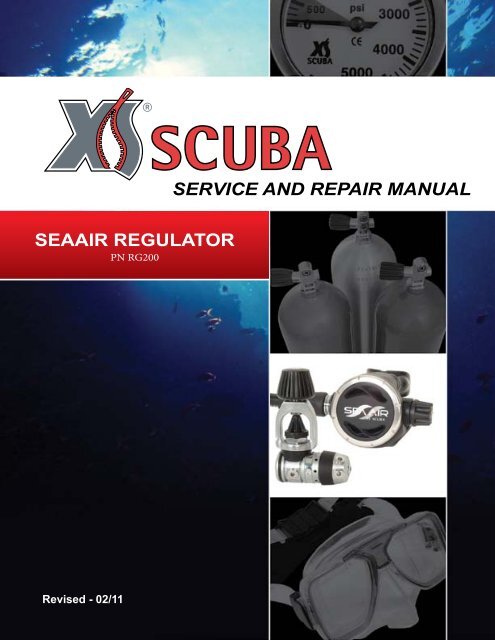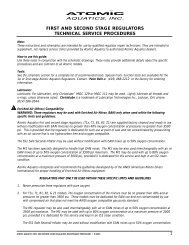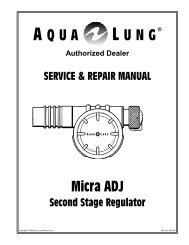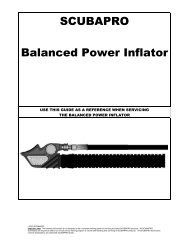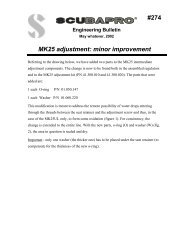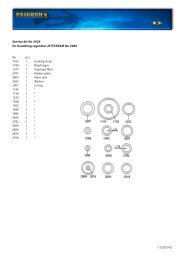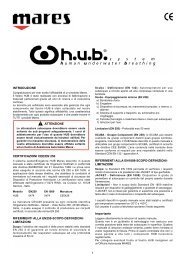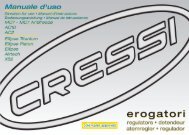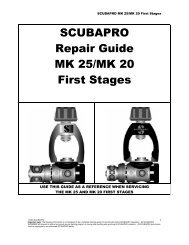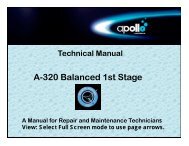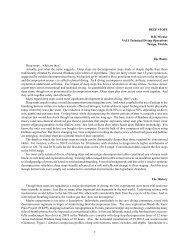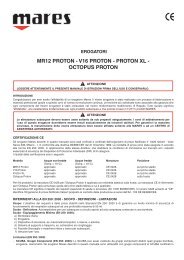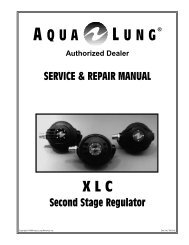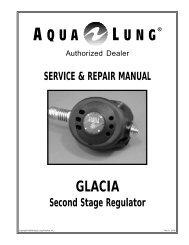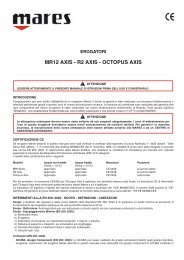Service & Repair Manual - Frogkick.dk
Service & Repair Manual - Frogkick.dk
Service & Repair Manual - Frogkick.dk
Create successful ePaper yourself
Turn your PDF publications into a flip-book with our unique Google optimized e-Paper software.
SERVICE AND REPAIR MANUAL<br />
SEAAIR REGULATOR<br />
PN RG200<br />
<strong>Service</strong> & <strong>Repair</strong> <strong>Manual</strong><br />
Revised - 02/11
SeaAir Regulator<br />
Contents<br />
Section 1 - Introduction<br />
Warnings, Cautions, & Notes.................................................................................................................................................3<br />
Scheduled <strong>Service</strong>....................................................................................................................................................................3<br />
EAN/ Nitrox <strong>Service</strong>...............................................................................................................................................................3<br />
Facility Requirements.............................................................................................................................................................4<br />
Specialty Tools.........................................................................................................................................................................5<br />
Section 2 - Preliminary Inspection<br />
External Inspection.................................................................................................................................................................6<br />
Immersion / Leak Test............................................................................................................................................................6<br />
Intermediate Pressure Test.....................................................................................................................................................7<br />
Section 3 - Disassembly Procedures<br />
General Guidelines..................................................................................................................................................................8<br />
First Stage Disassembly..........................................................................................................................................................9<br />
Second Stage Disassembly....................................................................................................................................................13<br />
Section 4 - Reassembly Procedures<br />
General Guidelines................................................................................................................................................................16<br />
First Stage Reassembly..........................................................................................................................................................17<br />
Second Stage Reassembly.....................................................................................................................................................21<br />
Section 5 - Final Testing Procedures<br />
First Stage Intermediate Pressure Test................................................................................................................................24<br />
Second Stage Adjustment and Flow Test............................................................................................................................25<br />
Subjective Breathing Test......................................................................................................................................................26<br />
Flowbench Testing (optional)..............................................................................................................................................27<br />
External Leak Test.................................................................................................................................................................27<br />
Troubleshooting Guide - First Stage...........................................................................28<br />
Troubleshooting Guide - Second Stage..................................................................29<br />
Schematics & Parts Lists<br />
SeaAir First Stage...................................................................................................................................................................30<br />
SeaAir Second Stage..............................................................................................................................................................31<br />
SeaAir Regulator <strong>Service</strong> and <strong>Repair</strong> <strong>Manual</strong><br />
2
<strong>Service</strong> & <strong>Repair</strong> <strong>Manual</strong><br />
SECTION<br />
1<br />
Introduction<br />
This manual provides factory prescribed procedures for the correct service and repair of the SeaAir<br />
regulator, including the first and second stage. It is not intended to be used as an instructional manual for<br />
untrained personnel. The procedures outlined within this manual are to be performed only by personnel<br />
who have received factory authorized training through a repair seminar that has been directly sponsored<br />
by XS Scuba.<br />
If you do not completely understand all of the procedures outlined in this manual, contact XS Scuba<br />
to speak directly with a Technical Advisor before proceeding any further.<br />
Warnings, Cautions, & Notes<br />
Pay special attention to information provided in Warnings, Cautions, and Notes that are accompanied<br />
by one of these symbols:<br />
A WARNING indicates a procedure or situation that may result in serious injury or death if instructions are not<br />
followed correctly.<br />
A CAUTION indicates any situation or technique that will result in potential damage to the product, or render<br />
the product unsafe if instructions are not followed correctly.<br />
A NOTE is used to emphasize important points, tips, and reminders.<br />
Scheduled <strong>Service</strong><br />
Because the SeaAir regulator is considered to be a life-supporting product, it is extremely critical that it<br />
receives service according to the procedures outlined in this manual on a regularly scheduled basis; at least<br />
once a year with normal or infrequent use.<br />
NOTE: A unit that receives heavy or frequent use, such as in rental, instruction, or commercial applications,<br />
should be serviced at least twice each year - or more often - depending on the conditions<br />
of use and the manner in which it is maintained. (Refer to the care and maintenance procedures<br />
outlined in the SeaAir User's Guide.)<br />
When performing service, whether it is a routine overhaul or a repair of a specific problem, it is important<br />
to understand how the regulator is designed and how it operates. If you have any questions, please<br />
consult your XS Scuba representative.<br />
EAN/ Nitrox <strong>Service</strong><br />
Newly manufactured XS Scuba regulators are assembled and packaged to be compatible with oxygen<br />
enriched air (EAN/ Nitrox), not to exceed 40% oxygen content. If the regulator is going to be used for this<br />
application, however, it must be dedicated and clearly labled as such, in order to prevent any crossover use<br />
with standard compressed air. Refer to the instructions provided in the XS Scuba Authorized<br />
<strong>Service</strong> Document, titled - Regulator Parts Cleaning Procedures.<br />
CAUTION: It is important to avoid using, testing, or otherwise pressurizing a dedicated EAN<br />
regulator with standard compressed air, which contains hydrocarbon contaminants.<br />
3 Copyright ©2011 XS Scuba
SeaAir Regulator<br />
Facility Requirements<br />
As an Authorized XS Scuba Dealer, your customers expect you to<br />
provide top-notch overhaul service, both before and after the sale. Next to<br />
airfills and gas blending, it is the single most important commodity your<br />
store can provide.<br />
The service department is therefore the most important part of your<br />
store. It should be clean and well lighted, and stocked with a complete inventory<br />
of parts and all the specialty tools you will need to get the job done<br />
right. As a minimum requirement, your service facility should be equipped<br />
with the following items:<br />
Ultrasonic Cleaner<br />
"Jaws" Gripmaster Vise<br />
❏ Ultrasonic Cleaner – Select the right size model that can keep up with<br />
the volume of equipment that your store services. A built in timer and<br />
heater will help control the cleaning time and temperature of the solution,<br />
since most solutions work best when heated.<br />
❏ Bench Mounted Vise – A vise is sometimes needed to hold the regulator<br />
secure – especially when removing the first stage yoke retainer.<br />
Special care must be taken, however, to avoid damage that can result<br />
from improper use of this tool. Be sure to follow the instructions provided<br />
in this manual.<br />
NOTE: XS Scuba especially endorses and recommends the Jaws<br />
Gripmaster Bench Vise, available from Peter Built Co. It is designed<br />
specifically for the professional dive store service bench, and will prevent<br />
damage that can easily be caused by a conventional vise.<br />
❏ Magnification Lamp – Strong lighting and magnification are essential<br />
requirements for performing a thorough parts inspection - especially<br />
when locating the source of a small leak.<br />
❏ Quality Wrenches & Sockets – When working with brass parts, it is<br />
especially critical to use the correct size wrench and to ensure that it<br />
fits properly over the part. The use of an adjustable wrench is very<br />
likely to cause damage to your customer's equipment, and should be<br />
strictly avoided at all times.<br />
❏ Calibrated Inch-Pound and Foot-Pound Torque Wrenches –<br />
It is important to follow the manufacturer's torque values whenever they<br />
are specified, in order to avoid overtightening or undertightening a part.<br />
This is especially important for smaller parts and fittings, when overtightening<br />
can easily damage the part. Torque wrenches that can be<br />
set for both inch-pound and foot-pound measurements tend to be less<br />
accurate than wrenches that are designed to measure torque within a<br />
specific range.<br />
SeaAir Regulator <strong>Service</strong> and <strong>Repair</strong> <strong>Manual</strong><br />
4
Specialty Tools<br />
<strong>Service</strong> & <strong>Repair</strong> <strong>Manual</strong><br />
For the finest tools, fixtures, and supplies that are designed and manufactured specifically for servicing<br />
SCUBA equipment, we recommend one source for all your service facility’s needs.<br />
Peter Built Co., in Galion, Ohio, is dedicated to serving the diving industry, and offers a wide selection of<br />
the most innovative specialty tools found anywhere to help you get the job done efficiently - and done right.<br />
Breaker Bar # 20-157-500<br />
(419) 468-2212<br />
3/8"<br />
Drive<br />
1" - SIX POINT<br />
PETER BUILT<br />
I” Yoke Nut Socket #20-155-500<br />
O-ring Tool Set #10-102-100<br />
Select Tool Kit (5 pcs) # 11-090-500<br />
260 2.0 x 50<br />
260 3.5 x 60<br />
Custom (narrow diameter)<br />
3/8" x 3" Drive Extension #20-156-500<br />
No. 4 Hook Spanner, #20-404-200<br />
Snap Ring Pliers # 10-101-500<br />
Poppet Align/ Orifice Preset Tool, #20-785-400<br />
100 150<br />
80<br />
125 175 120<br />
100 IP RANGE 200<br />
125-150 PSI<br />
60<br />
140<br />
75<br />
225<br />
IP RANGE<br />
125-150 PSI<br />
40<br />
160<br />
50<br />
250<br />
M<br />
Piston Installation Bullet<br />
25 20<br />
PSI<br />
USE PSI NO OIL 180 275<br />
0<br />
USE NO OIL<br />
200 300<br />
PETER BUILT<br />
"Quality PETER in BUILT the making" CO.<br />
"Quality in the making"<br />
(419) 468-2212<br />
(419) 468-2212<br />
Intermediate Pressure<br />
Test Gauge, #20-510-100<br />
Dual Drive In-Line Adjusting Tool # 20-500-200 Second Stage Rim Clamp #20-790-200<br />
Required Tools/ Lubricant<br />
No. 4 Hook Spanner Wrench PN #20-404-200<br />
Dual Drive Adjusting Tool PN #20-500-200<br />
Tech Driver IPG PN #20-165-111<br />
O-ring Tool Set<br />
PN#10-125-400<br />
1/4" Slotted Screwdriver PN #11-465-500<br />
1/4" Nut Driver PN #11-168-500<br />
Small (.02) Blade Screwdriver PN #11-133-500<br />
Cristo Lube<br />
PN #MS150<br />
Hakko Side Cuts, 5" PN #16-020-500<br />
Snap Ring Pliers<br />
11/16" Open End Wrench<br />
3/4" Open End Wrench<br />
Illustrations courtesy of Peter Wolfinger.<br />
Galion, OH 44833<br />
Phone: 419-468-2212<br />
www.scubatools.com<br />
5 Copyright ©2011 XS Scuba
SeaAir Regulator<br />
SECTION<br />
2<br />
Preliminary Inspection<br />
External Inspection<br />
1. Closely examine the conical filter to check for any signs that<br />
contaminants have entered the system, including sea water, rust,<br />
or aluminum oxide.<br />
NOTE: A green discoloration of the filter indicates that<br />
moisture has entered the regulator, and internal corrosion has<br />
possibly occurred. Other types of discoloration may indicate<br />
that the regulator has been used with a corroded cylinder.<br />
Advise the customer of this, and the possible need to obtain<br />
service for the cylinder.<br />
2. Slide back the hose protectors, if present, to visually inspect the<br />
condition of the hoses, especially at their fittings.<br />
3. Closely examine the finish of the first stage to check for any<br />
chips, scratches, or other damage that exposes the brass beneath<br />
the finish.<br />
CAUTION: Do not clean any parts that show damage to their<br />
finish inside an ultrasonic cleaner.<br />
4. Closely examine all parts of the first stage for any other signs of<br />
external corrosion.<br />
Immersion / Leak Test<br />
1. Check to ensure that the regulator is fully assembled and connected<br />
to a second stage, and that there are no open ports or<br />
hoses. Connect the first stage to a cylinder that is filled with<br />
3,000 psi, and open the cylinder valve to pressurize the regulator.<br />
2. If leakage cannot be heard, or if the source of leakage detected<br />
audibly is not obvious, immerse the first stage in fresh water to<br />
check further for any signs of air leakage, especially at the fittings<br />
of hoses.<br />
3. Note the source of any leakage found and refer to<br />
the Troubleshooting Guide to determine its possible cause.<br />
4. Close the cylinder valve and depress the second stage purge<br />
button to depressurize the regulator before performing the next<br />
procedure.<br />
Intermediate Pressure Test<br />
SeaAir Regulator <strong>Service</strong> and <strong>Repair</strong> <strong>Manual</strong><br />
6
<strong>Service</strong> & <strong>Repair</strong> <strong>Manual</strong><br />
NOTE: It is not necessary to perform this test unless a problem<br />
has been reported that requires diagnostic troubleshooting<br />
and repair. When performing routine overhaul service,<br />
proceed directly to the following section, Disassembly.<br />
1. Connect a calibrated intermediate pressure test gauge to the<br />
regulator, either with a quick-disconnect inflator hose or with<br />
the female fitting of a second stage LP hose, depending on the<br />
connection of the test gauge.<br />
CAUTION: To provide a safety relief valve in the event that<br />
intermediate pressure exceeds 155-170 psi, ensure that a fully<br />
assembled and properly adjusted second stage is connected<br />
to the first stage before pressurizing. Failure to relieve intermediate<br />
pressure that exceeds 400 psi may result in damage<br />
or rupture of the test gauge or LP hose, and could cause<br />
serious personal injury.<br />
2. Slowly open the supply valve to pressurize the first stage. Closely<br />
monitor the IP test gauge to determine whether the intermediate<br />
pressure rises above 145 psi.<br />
3. Note the intermediate pressure indicated by the test gauge, and<br />
purge the second stage several times to determine whether<br />
lockup is achieved without creeping or fluctuating back and<br />
forth.<br />
4. If the intermediate pressure creeps up or otherwise fluctuates<br />
after cycling the regulator, wait for it to stabilize (if possible)<br />
before making a final note of the intermediate pressure.<br />
NOTE: Correct intermediate pressure for the first stage is<br />
140 (±5) psi, with an inlet pressure between 2,500 - 3,000 psi.<br />
5. Close the supply valve and depress the second stage purge button<br />
to depressurize the system before attempting to perform any<br />
disassembly.<br />
▼ After completing the Preliminary Inspection, proceed<br />
to Section 3 – Disassembly<br />
7 Copyright ©2011 XS Scuba
SeaAir Regulator<br />
SECTION<br />
3<br />
Disassembly Procedures<br />
General Guidelines<br />
▼ Prior to performing any disassembly, check to ensure that the<br />
service facility is well equipped with all the tools and parts needed<br />
to perform a complete service from start to finish. DO NOT<br />
attempt to perform the service unless all of the required tools<br />
and parts are available.<br />
▼ All o-rings are classified as being either dynamic or static.<br />
Dynamic o-rings are those which sustain friction and movement,<br />
as they are either mounted directly onto a moving part,<br />
or create a seal against a moving part. Static o-rings simply<br />
create a seal between two non-moving parts, and are therefore<br />
less subject to wear than dynamic o-rings. After passing close<br />
inspection, static<br />
O-rings may sometimes be reused, although this is not necessarily<br />
recommended. Dynamic O-rings must be automatically<br />
discarded and replaced with every service, regardless of age or<br />
appearance.<br />
▼ Refer to the schematic and parts list while performing these<br />
procedures. Each part is identified by its reference number<br />
shown on the drawing the first time it is referred to in the procedure.<br />
▼ Do not attempt to reuse parts that are designated to be automatically<br />
discarded and replaced with the parts provided in the<br />
overhaul parts kit. These parts should be shown to the customer,<br />
however, to ensure their confidence and satisfaction that<br />
complete overhaul service has been performed.<br />
▼ Inspect all reusable parts as directed, either during or immediately<br />
following the disassembly procedures. When in doubt,<br />
compare the part with one that is new to best determine its<br />
condition.<br />
SeaAir Regulator <strong>Service</strong> and <strong>Repair</strong> <strong>Manual</strong><br />
8
<strong>Service</strong> & <strong>Repair</strong> <strong>Manual</strong><br />
First Stage Disassembly<br />
CAUTION: Whenever possible, use only plastic or brass O-ring<br />
tools for removing O-rings in order to prevent damage to the sealing<br />
surface. Steel instruments, such as dental picks, can easily damage<br />
the sealing surface of a softer brass part, causing irreparable<br />
leakage and requiring the part to be replaced with new.<br />
1. Before disassembling the first stage, remove the low pressure<br />
second stage hose with a 15mm open end wrench, the high<br />
pressure hose with a s" open end wrench, and the low pressure<br />
inflator hose with a 2" (or other size required) open end wrench.<br />
Remove all remaining port plugs(17&32) with a x" hex key.<br />
2. Remove and inspect the O-rings(16&31) on these items to determine<br />
their condition, and discard them if any signs of decay<br />
are found.<br />
3. Remove the dust cap(3) from the yoke(4).<br />
NOTE: It will be necessary to use a bench mounted vise to<br />
hold the first stage secure throughout this procedure. This<br />
ensures the best protection against slippage and accidental<br />
damage to soft metal parts. If an ordinary bench vise will be<br />
used, the first stage must be mounted outside the vise with<br />
the use of a vise mounting tool fastened into the high pressure<br />
port. To ensure the best available protection against<br />
damage, XS Scuba specifically recommends the<br />
Gripmaster Vise, available from Peter Built Co.<br />
4. Secure the first stage in a vise as described above, with the yoke<br />
and yoke screw(2) facing up (See Fig. 1).<br />
Fig. 1 – Correct vise mounting<br />
5. Disassembly of the Yoke Connector<br />
a. Loosen the yoke screw several turns counter-clockwise.<br />
Place a 1" Yoke Retainer Socket (available from Peter Built<br />
Co.) inside the yoke and over the hex features of the yoke<br />
retainer(8). Pass a Breaker Bar (available from Peter Built<br />
Co.) through the yoke, and tighten the yoke screw clockwise<br />
until it is lightly snug over the dimpled feature of the<br />
breaker bar (see Fig. 2). Then, grasp the breaker bar with<br />
both hands on opposite ends and turn the socket counterclockwise<br />
with steady force to loosen the yoke retainer. Do<br />
not use impact.<br />
CAUTION: The socket and breaker bar combination provide<br />
the best insurance against damage while removing the yoke<br />
retainer, using the procedure described above. DO NOT, un-<br />
Fig. 2 – Yoke Retainer Removal<br />
9 Copyright ©2011 XS Scuba
SeaAir Regulator<br />
der any circumstances, use an adjustable wrench or an open<br />
end wrench that does not fit completely over the flats on both<br />
sides. Doing so may result in permanent damage to the yoke<br />
retainer, requiring its replacement.<br />
Fig. 3 – Removal of Filter Retaining Ring<br />
Fig. 4 – Removal of DIN Retainer<br />
Fig. 5 – Removal of HP Seat Retainer<br />
b. Turn the yoke screw counter-clockwise to remove it from<br />
the yoke, and set aside the breaker bar and socket.<br />
c. Unscrew the yoke retainer counter-clockwise to remove<br />
from the body, along with the yoke and saddle(10).<br />
d. Remove the main seal O-ring(9) from the yoke retainer.<br />
Discard the O-ring and do not reuse, regardless of its condition.<br />
e. While holding the yoke retainer secure, apply a pair of Snap<br />
Ring Pliers to remove the retaining ring(5) from the yoke<br />
retainer (see Fig. 3). Tap out the filter(6), and remove the<br />
O-ring(7) inside with a brass O-ring tool. Discard the filter<br />
and O-ring, and do not reuse either part regardless of their<br />
condition.<br />
6. Disassembly of the DIN Connector<br />
a. Secure the first stage in the vise with the DIN connector facing<br />
straight up. (See Fig. 4.)<br />
b. Apply a 4" hex key to the DIN retainer(4f), and turn it<br />
counter-clockwise to loosen and remove from the body,<br />
along with the handwheel(4a) and saddle(4d).<br />
c. Remove the DIN retainer from the handwheel, and then remove<br />
and discard: the filter(4g) and both O-rings(4e&4h).<br />
Do not attempt to reuse these parts.<br />
c. Closely inspect the condition of the DIN retainer and<br />
handwheel to ensure that the threads are free of any burrs or<br />
other damage. If thread damage is found that could impair<br />
a proper connection, it is important to replace the part with<br />
new.<br />
d. Inspect the condition of the thrust washer(4b), spacer(4c),<br />
and saddle, and replace if needed.<br />
7. Resecure the first stage in the vise with the body(18) positioned<br />
vertical, and the LP swivel facing down.<br />
8. Apply a 4" hex key to the HP seat retainer(11) and turn it counter-clockwise<br />
to loosen and remove (see Fig. 5). Remove and<br />
discard the O-ring(12).<br />
9. Using a brass O-ring tool, carefully lift out the O-ring(14) inside<br />
the HP chamber (see Fig. 6). Be careful to avoid touching the<br />
exposed seating edge of the piston shaft. Discard the O-ring,<br />
regardless of its condition.<br />
10. While holding the HP seat retainer secure with a cloth covering<br />
SeaAir Regulator <strong>Service</strong> and <strong>Repair</strong> <strong>Manual</strong><br />
10
<strong>Service</strong> & <strong>Repair</strong> <strong>Manual</strong><br />
the HP seat, apply a short blast of low pressure air through the<br />
small hole to dislodge the HP seat(13). (See Fig. 7.) Discard the<br />
seat, and do not reuse.<br />
11. Resecure the first stage in the vise with the body positioned<br />
vertical, and the LP swivel facing up.<br />
12. Apply a spanner wrench to one of the larger bore holds of the<br />
piston cap(25), and hold it securely seated to turn the cap counter-clockwise<br />
to loosen it from the first stage body. (See Fig. 8.)<br />
Turn the piston cap further by hand to loosen and remove, until<br />
it can be carefully lifted straight off the body, along with the<br />
piston(22).<br />
13. Gently remove the piston from the piston cap, and then remove<br />
and discard the piston head O-ring(23). Set the piston aside<br />
with the shaft facing up, to be kept isolated from other metal<br />
parts or work surfaces that might damage the polished seating<br />
edge.<br />
14. Remove the high pressure valve spring(21) and spring isolator(20)<br />
from the body. Inspect the spring isolator for any signs<br />
of damage or distortion, and discard if any is found. Closely<br />
inspect the spring with a magnifier to check for any signs of<br />
damage or corrosion that has permeated the wall of the metal.<br />
Set the spring aside to be reused if it is determined to be in<br />
satisfactory condition with no signs of permanent corrosion or<br />
damage.<br />
CAUTION: If damage is found, or if the intermediate pressure<br />
was measured lower than 135PSI during preliminary<br />
inspection, replace the spring with new. DO NOT attempt to<br />
boost the intermediate pressure by adding spring isolators<br />
unless a new spring has first been installed.<br />
Fig. 6 – Removal of HP Static Oring<br />
Fig. 7 – Removal of HP Seat<br />
NOTE: If corrosion is found on the spring, check for any<br />
signs that moisture may have entered the first stage. If evidence<br />
of moisture is found inside the first stage, it is important<br />
to inspect all parts that could provide a possible leak path,<br />
either due to damage or improper assembly.<br />
15. Remove the first stage from the vise, and remove the vise<br />
mounting tool if one was used.<br />
16. Using a brass O-ring tool, remove the small dynamic O-ring(19)<br />
from the first stage body, being careful to avoid damaging the<br />
sealing surface of the internal groove.<br />
17. To remove the large external O-ring(15), pinch it between<br />
thumb and forefinger with one hand, and then apply an O-ring<br />
Fig. 8 – Loosening Piston Cap<br />
11 Copyright ©2011 XS Scuba
SeaAir Regulator<br />
Fig. 9 – Removal of Swivel Retainer<br />
tool to remove it with the other.<br />
18. Secure the swivel cap(30) in a vise, using either the "Jaws Gripmaster,"<br />
or with a vise mounting tool installed in one of the LP<br />
ports. Ensure that the piston cap is facing up.<br />
19. Mate a c" (8mm) hex key through the open piston cap and<br />
into the hex of the swivel retainer(24). (See. Fig. 9.) Turn the<br />
swivel retainer counter-clockwise to loosen and remove, and<br />
lift the piston cap off the swivel cap.<br />
20. Remove the swivel retainer from the piston cap, along with the<br />
swivel washer(27). Examine the condition of the washer, and<br />
reuse or replace it as needed.<br />
21. Remove and discard both O-rings(27&28) from the swivel cap,<br />
and automatically discard them regardless of their condition.<br />
22. Using a smooth plastic or brass probe, remove the rubber collar(26)<br />
from the piston cap. Examine the ring to determine its<br />
condition, and replace with new as needed.<br />
23. Under strong lighting, closely inspect the inner bore and all<br />
sealing surfaces of the first stage body with a magnifier, including<br />
the intermediate and high pressure ports, and the inlet<br />
port. Check to ensure there are no scratches or other damage<br />
that could contribute to leakage. If damage is found that is<br />
determined to cause irreparable leakage, it will be necessary to<br />
discard the first stage body and replace it with new.<br />
▼ After completing the disassembly of the first stage,<br />
proceed to the following procedure - Second Stage<br />
Disassembly.<br />
SeaAir Regulator <strong>Service</strong> and <strong>Repair</strong> <strong>Manual</strong><br />
12
<strong>Service</strong> & <strong>Repair</strong> <strong>Manual</strong><br />
Second Stage Disassembly<br />
CAUTION: Whenever possible, use only plastic or brass<br />
O-ring tools for removing O-rings in order to prevent damage<br />
to the sealing surface. Steel instruments, such as dental<br />
picks, can easily damage the sealing surface of a softer brass<br />
part, causing irreparable leakage and requiring the part to be<br />
replaced with new.<br />
1. Slide back the hose cover to expose the connection of the LP<br />
hose.<br />
2. While holding the inlet fitting(20) secure with a n" open-end<br />
wrench, apply another n" open-end wrench to the fitting of<br />
the LP hose. Turn the fitting counter-clockwise to loosen and<br />
remove.<br />
3. Using a plastic or brass O-ring tool, carefully remove the O-ring<br />
from the post inside the hose fitting.<br />
CAUTION: When performing the above step, be very careful<br />
to avoid scratching the O-ring sealing surface. Doing so<br />
may cause a permanent leak that will require the replacement<br />
of the LP hose.<br />
4. Using a n" open end wrench, turn the inlet fitting counterclockwise<br />
to loosen, and unscrew it completely by hand to<br />
remove.<br />
5. Snip the plastic tie-strap(21) that holds the mouthpiece(23), and<br />
gently pull the mouthpiece off the second stage housing(12).<br />
Inspect the mouthpiece to ensure that it is supple and free of<br />
any tears or corrosion. If any damage is found that could result<br />
in discomfort or leakage, discard the mouthpiece and do not<br />
reuse.<br />
6. While holding the second stage secure with one hand, firmly<br />
grasp the retaining ring(17) with the other, and turn the ring<br />
counter-clockwise to loosen and remove it, along with the diaphragm<br />
cover(16).<br />
NOTE: If the retaining ring is difficult to loosen, XS Scuba<br />
recommends using the Rim Clamp (P/N 20-790-200), available<br />
from Peter Built Co. Complete instructions are provided<br />
with the tool.<br />
7. Separate the diaphragm cover from the retaining ring, and<br />
closely inspect the cover to ensure that it is perfectly round and<br />
free of any distortion or other damage. If any damage is found,<br />
discard the cover and replace with new.<br />
13 Copyright ©2011 XS Scuba
SeaAir Regulator<br />
Fig. 10 – Removal of Retaining Clip<br />
Fig. 11 – Removal of Valve Assembly<br />
Fig. 12 – Removal of Adjustment Knob<br />
8. Lift out the diaphragm(14) and thrust washer(15) from the<br />
second stage housing. Inspect the diaphragm to ensure that it is<br />
supple and free of any pinholes, tears, corrosion, or other damage.<br />
If any damage is found, discard it and replace with new.<br />
9. Using a small flat blade screwdriver, rotate the metal retaining<br />
clip(13) over the groove of the adjustment knob(1) as needed so<br />
that the notch in the center is visible. Place the tip of a 2mm flat<br />
blade screwdriver inside this notch, and gently lift the clip off<br />
the groove. (See Fig. 10.)<br />
10. While holding the lever(18) lightly depressed, slide the entire<br />
valve assembly out of the second stage housing, adjustment<br />
knob first (see Fig. 11). Remove and discard the inlet fitting O-<br />
ring(19).<br />
11. Unscrew the adjustment knob counter-clockwise from the air<br />
barrel(8), and carefully remove the O-ring(2) with a plastic tool.<br />
12. Turn the air barrel over to allow the balance shuttle cap(3) and<br />
LP spring(4) to drop out (see Fig. 12). Inspect the spring closely<br />
with a magnifier to check for any signs of corrosion. Discard it<br />
if corrosion is found, and do not reuse.<br />
13. Gently remove the lever from the air barrel by lifting out one leg<br />
first, and then the other. Be careful to avoid bending or stretching<br />
either leg.<br />
14. Turn the air barrel over to allow the poppet(6) to drop out. Using<br />
fingernails or a plastic tool, carefully remove the LP seat(7)<br />
and small O-ring(5). Discard both soft parts, and do not reuse.<br />
Closely inspect the poppet around all seating surfaces, and<br />
compare it with new to ensure no damage is visible. If damage<br />
is found, discard the poppet and replace with new.<br />
15. Remove the white lever pad(9) from the air barrel. Discard, and<br />
do not reuse.<br />
16. While holding the air barrel secure, apply a medium blade<br />
screwdriver to the slotted head of the adjustable orifice(10), and<br />
turn it counter-clockwise to disengage its threads.<br />
NOTE: The orifice is O-ring sealed, and it will remain inside<br />
the air barrel after it has been unthreaded. The following step<br />
must be performed correctly in order to remove the orifice<br />
without damaging its polished sealing surface.<br />
17. When the orifice has been unthreaded from the air barrel, carefully<br />
insert a small wooden or plastic dowel through the opposite<br />
end of the valve body, directly over the sealing edge of the<br />
orifice. Gently press out the orifice. (See Fig. 13.)<br />
18. To avoid using a sharp tool that can damage the orifice, squeeze<br />
the O-ring(11) between thumb and forefinger to remove it from<br />
SeaAir Regulator <strong>Service</strong> and <strong>Repair</strong> <strong>Manual</strong><br />
14
<strong>Service</strong> & <strong>Repair</strong> <strong>Manual</strong><br />
the orifice head. Discard the O-ring and do not reuse.<br />
19. Closely examine the orifice with the use of a magnifier, checking<br />
for any scratches or other damage to the sealing edge and<br />
the groove that holds the O-ring (see Fig. 14). If any damage or<br />
wear is found, discard the orifice and do not attempt to reuse. If<br />
it is in reusable condition, set it aside on a soft surface to keep it<br />
isolated from other metal parts.<br />
20. Remove the exhaust deflector(24) from the second stage housing<br />
to expose the exhaust valve(22) for inspection.<br />
NOTE: To facillitate the removal of the exhaust deflector,<br />
first place it in hot (120°-150°F) water for 2-3 minutes and<br />
allow it to soften.<br />
Fig. 13 – Removal of Adjustable Orifice<br />
21. Closely inspect the exhaust deflector to check for any signs of<br />
damage that may have been caused by abuse or improper disassembly.<br />
If found, discard it and replace with new.<br />
22. Closely inspect the condition of the exhaust valve to ensure that<br />
it is evenly seated against the second stage housing on all sides,<br />
and free of any tears, holes, or other signs of decay. Peel back<br />
the lip on all sides to ensure it is supple and returns to its original<br />
position. If any wear or damage is detected, or if the material<br />
feels stiff or decayed, pull the exhaust valve straight out of<br />
the housing and discard it.<br />
NOTE: It is not necessary to remove the exhaust valve<br />
diaphragm unless it shows signs of wear or decay upon inspection.<br />
Once the diaphragm is removed, however, it will be<br />
permanently stretched and then must be replaced with new.<br />
▼ After completing the disassembly of the first and<br />
second stages, refer to the instructions provided in<br />
the XS Scuba Authorized <strong>Service</strong> Document, titled -<br />
Regulator Parts Cleaning Procedures.<br />
Fig. 14 – Orifice Inspection<br />
15 Copyright ©2011 XS Scuba
SeaAir Regulator<br />
SECTION<br />
4<br />
Reassembly Procedures<br />
General Guidelines<br />
▼<br />
▼<br />
▼<br />
▼<br />
▼<br />
Refer to the schematic parts list, that highlights automatic replacement parts<br />
which should be discarded and replaced with new during reassembly. These<br />
parts are provided in the Annual <strong>Service</strong> Kit.<br />
Before performing any reassembly, it is important to individually inspect all<br />
parts, both new and those that are being reused, to ensure that each part<br />
and component is perfectly clean and free of any dust, decay, or blemishes.<br />
If the regulator has been serviced for use with EAN/Nitrox, it is important to<br />
don powderless latex gloves before handling any parts, including O-rings, in<br />
order to avoid contaminating the parts with skin oil.<br />
Prior to dressing, inspect all O-rings with magnification to ensure they are<br />
supple, clean, and completely free of any scoring or decay that would impair<br />
proper sealing.<br />
XS Scuba recommends Christo-Lube ® MCG-11 (PN MS150) to be used exclusively<br />
for the lubrication and dressing of O-rings and other internal parts.<br />
Christo-Lube ® provides superior lubrication to that of silicone grease, especially<br />
in high pressure (DIN) systems greater than 3,000 psi, and extreme<br />
temperature conditions. It is also non-reactive to oxygen, and is approved for<br />
use with EAN/Nitrox.<br />
'<br />
CAUTION: Silicone grease is not compatible with oxygen enriched<br />
air, and must be strictly avoided when servicing a regulator that<br />
will be used with EAN/ Nitrox. The entire regulator will otherwise<br />
become contaminated, and rendered unsafe for use with any mixture<br />
of oxygen enriched air.<br />
▼<br />
Dress all O-rings with a visible film of Christo-Lube, but avoid applying excessive<br />
amounts, as this may attract particulate matter that can cause accelerated<br />
wear or damage to the O-ring.<br />
CAUTION: The use of aerosol spray or petroleum based lubricants<br />
must be strictly avoided. The propellant gas or petroleum base may<br />
attack or weaken plastic or rubber parts.<br />
▼<br />
Use all replacement parts provided in the XS Scuba Authorized Dealer parts<br />
kit.<br />
SeaAir Regulator <strong>Service</strong> and <strong>Repair</strong> <strong>Manual</strong><br />
16
<strong>Service</strong> & <strong>Repair</strong> <strong>Manual</strong><br />
First Stage Reassembly<br />
WARNING: DO NOT attempt to use any other manufacturer's<br />
part as a substitute for any XS Scuba part, regardless of<br />
any similarity in shape, size, or appearance. Doing so may<br />
render the product unsafe, and could result in serious injury<br />
or death.<br />
1. Lubricate and install the small dynamic O-ring(19) into the<br />
first stage body(18), checking to ensure that it is seated properly<br />
inside the groove.<br />
2. Install the large external O-ring(15) onto the groove near the<br />
end of the body.<br />
3. Generously lubricate and install the large dynamic O-ring(23)<br />
onto the head of the piston(22), and stand the piston on its<br />
head.<br />
4. Apply a light film of lubricant to both ends of the high pressure<br />
spring(21), and place the spring over the shaft of the piston.<br />
5. Lay the spring washer(20) over the top of the spring.<br />
NOTE: If more than one washer was removed during disassembly,<br />
be sure to reassemble the first stage using the same<br />
number of washers, unless the HP spring has been discarded<br />
and replaced with new. Up to three washers may be used.<br />
▼ If one is needed, install between the spring and body.<br />
▼ If two are needed, install on opposite sides of spring.<br />
▼ If three are needed, install one between the spring and body,<br />
and two between the spring and piston.<br />
6. Insert a piston installation bullet into the end of the piston shaft.<br />
This will protect the small dynamic O-ring inside the body, and<br />
also the polished sealing surface of the piston (see Fig. 15).<br />
7. Gently lower the threaded end of the body over the piston shaft,<br />
until the body is supported by the spring . While holding the<br />
piston and body together, turn the body over to allow the piston<br />
installation bullet to drop out of the opposite end, tapping it<br />
loose if necessary (see Fig. 16). Stand the body on end, with the<br />
piston head facing up.<br />
8. Lubricate and install the large O-ring(28) into the groove of the<br />
swivel cap(30), and the smaller dynamic O-ring(28) onto the<br />
swivel stem. (See Fig. 17.)<br />
Fig. 15 – Piston w/ Installation Bullet<br />
Fig. 16 – Removal of Bullet<br />
9. Mate the smaller end of the piston cap(25) over the stem of the<br />
swivel cap, and press it downward so that it snaps securely into<br />
place.<br />
Fig. 17 – Swivel Retainer w/ O-rings<br />
17 Copyright ©2011 XS Scuba
SeaAir Regulator<br />
Fig. 18 – Assembly of Piston Cap w/ Body<br />
10. Install the swivel washer(27) over the shoulder of the swivel<br />
stem, inside the piston cap, and ensure that it is seated securely<br />
and evenly around the base.<br />
11. Being careful to avoid disturbing the position of the swivel<br />
washer, mate the threaded end of the swivel retainer(24)<br />
through the piston cap and into the stem of the swivel cap. Turn<br />
it clockwise to engage the threads, and tighten it until finger<br />
snug.<br />
12. Secure the swivel cap(30) in a vise, using either the "Jaws Gripmaster,"<br />
or with a vise mounting tool installed in one of the LP<br />
ports. Ensure that the piston cap is facing up.<br />
13. Apply an inch-pounds torque wrench with c" (8mm) hex key to<br />
tighten the swivel retainer to a torque measurement of 80 inchlbs,<br />
and remove the swivel assembly from the vise.<br />
14. Fit the large diameter end of the rubber collar(26) over the<br />
swivel cap, and press it down until the smaller end seats into<br />
place.<br />
NOTE: If the first stage is going to be prepared for use in<br />
severe conditions (cold or silty water), do not install the collar<br />
at this time. Refer to the instructions provided at the end of<br />
this procedure for installing the IceBreaker environmental<br />
sealing collar.<br />
Fig. 19 – HP Seat Installation<br />
15. Gently mate the piston cap straight down over the head of the<br />
piston, and tighten the piston cap and body together by hand<br />
until snug. (See Fig. 18.)<br />
16. Lubricate and install the O-ring(12) onto the HP seat retainer, at<br />
the base of the threads.<br />
17. Install the high pressure seat(13) into the HP seat retainer(11)<br />
with the concave dimple facing out. (See Fig. 19.)<br />
18. Lubricate and install the O-ring(14) inside the first stage body,<br />
using a smooth probe if necessary to ensure that it is seated<br />
evenly over the shoulder at the base of the high pressure chamber.<br />
19. Mate the HP seat retainer into the first stage body, and turne<br />
clockwise by hand until finger snug.<br />
20. Secure the first stage vertically in a vise, with the LP swivel assembly<br />
facing down.<br />
21. Apply an foot-pounds torque wrench with 4" hex key to tighten<br />
the HP seat retainer to a torque measurement of 18 foot-lbs.<br />
22. Resecure the first stage in the vise, turned over with the LP<br />
swivel assembly and piston cap facing straight up.<br />
SeaAir Regulator <strong>Service</strong> and <strong>Repair</strong> <strong>Manual</strong><br />
18
<strong>Service</strong> & <strong>Repair</strong> <strong>Manual</strong><br />
23. Apply a spanner wrench to one of the larger bore holes of the<br />
piston cap(25), and hold it securely seated to tighten the cap<br />
clockwise until snug. Do not overtighten. (See Fig. 20.)<br />
24. Resecure the first stage in the vise, positioned horizontal, with<br />
the inlet port facing up.<br />
25. Reassembly of the Yoke Connector<br />
a. Install the O-ring(7) into the yoke retainer(8), followed by<br />
the conical filter(6). Closely examine the retaining clip(5)<br />
to compare the difference of one side, which is flat, from the<br />
other which is rounded. Using snap ring pliers, install the<br />
retaining ring into the groove above the filter, with the flat<br />
side facing out.<br />
b. Lubricate and install the main seal O-ring(9) into the groove<br />
in the bottom of the yoke retainer.<br />
c. Being careful to ensure that the O-ring remains properly<br />
seated, insert the threaded end of the yoke retainer through<br />
the bottom of the yoke(4). While holding the saddle in<br />
place together with the first stage body, mate the yoke<br />
retainer into the inlet port of the body. Tighten the yoke<br />
retainer clockwise by hand until finger snug.<br />
d. Apply a torque wrench with the 1” Yoke Nut Socket and<br />
3"xa" Socket Drive Extension (available from Peter Built<br />
Co.). Tighten the yoke retainer to 24 foot-lbs (±1). (See Fig.<br />
21.)<br />
e. Install the dust cap(3) onto the yoke, and mate the yoke<br />
screw(2) into the yoke. Turn the screw one to two revolutions<br />
clockwise to engage the threads.<br />
Fig. 20 – Tightening Piston Cap<br />
3/8” Drive Torque Wrench<br />
3500 PSI<br />
PETER BUILT<br />
1" - SIX POINT<br />
26. Reassembly of the DIN Connector<br />
a. Mate the threaded end of the DIN retainer through the<br />
threaded side of the handwheel.<br />
b. While holding the retainer and handwheel together, fit<br />
the thrust washer(4b), spacer(4c), and saddle(4d) over the<br />
threaded end of the DIN retainer, in respective order.<br />
Fig. 21 - Torquing Yoke Retainer<br />
PETER B<br />
(419) 468<br />
c. Install the filter(4g) and both O-rings(4e&4h)into the DIN<br />
retainer.<br />
d. Mate the DIN retainer into the inlet port of the first stage<br />
body, and turn clockwise by hand until snug. Apply a<br />
torque wrench with a 4” hex key to tighten the DIN retainer<br />
to a torque measurement of 24 foot-lbs (±1).<br />
27. Loosen the vise to remove the first stage, and remove the vise<br />
mounting tool if one was used.<br />
19 Copyright ©2011 XS Scuba
SeaAir Regulator<br />
28. Lubricate and install the O-rings(16&31) onto all hoses and<br />
port plugs. Install the LP hoses and port plugs(17&32) into<br />
their respective ports in the first stage. Apply a calibrated<br />
torque wrench with x" hex key socket (or appropriate size crow<br />
foot for hoses) to tighten the port plugs and hoses to a torque<br />
measurement of 38 inch-lbs (±2).<br />
IceBreaker Environmental Seal Instructions<br />
WARNING: DO NOT install the IceBreaker environmental<br />
sealing collar without first packing the ambient chamber with<br />
silicone grease purchased directly from XS Scuba, according<br />
to the following instructions. Failure to do will seriously affect<br />
the regulator's performance, and could result in serious<br />
injury or death.<br />
1. Using a narrow tipped oral syringe, slowly inject silicone grease<br />
through the ports on all sides of the piston cap. Rotate among<br />
opposing ports, and repeat as needed until the pressure forces<br />
excess grease to exit the opposite sides, indicating that the<br />
chamber is full.<br />
2. After verifying that the chamber is complete filled with grease,<br />
wipe the outer surface of the piston cap clean with a soft cloth.<br />
3. Fit the larger end of the IceBreaker collar down over the top of<br />
the swivel cap, until it is securely in place over the piston cap,<br />
and the smaller end is seated in the groove just below the swivel<br />
(see Fig. 22).<br />
• After completing the reassembly of the first stage,<br />
proceed to the following procedure - Second Stage<br />
Reassembly<br />
Fig. 22 – IceBreaker Environmental Collar<br />
SeaAir Regulator <strong>Service</strong> and <strong>Repair</strong> <strong>Manual</strong><br />
20
<strong>Service</strong> & <strong>Repair</strong> <strong>Manual</strong><br />
Second Stage Reassembly<br />
WARNING: DO NOT attempt to use any other manufacturer's<br />
part as a substitute for any XS Scuba part, regardless of<br />
any similarity in shape, size, or appearance. Doing so may<br />
render the product unsafe, and could result in serious injury<br />
or death.<br />
1. Install the exhaust valve(22) into the second stage housing(12)<br />
by gently pulling the stem through the hole in the center of the<br />
sealing area, until the barb has passed through and is seated<br />
inside.<br />
NOTE: Prior to installing the exhaust deflector(24), place it in<br />
hot (120°-150°F) water for 2-3 minutes and allow it to soften.<br />
Fig. 23 – Lever Pad Features<br />
2. Fit the exhaust deflector(24) over the top ridge of the second<br />
stage housing, so that the two corners are securely seated, and<br />
then stretch the lower portion down until it snaps securely into<br />
place.<br />
CAUTION: Do not use a tool to install the exhaust deflector.<br />
Doing so may cause serious damage to the seating flange,<br />
requiring replacement of the housing.<br />
3. Closely examine both sides of the white lever pad(9) to identify<br />
that the mounting tabs on both legs are rounded on one side<br />
and flat on the other. (See Fig. 23.) Hold the air barrel with the<br />
flat cut facing down, and place the clip over the tube with the<br />
rounded side facing toward the flange, so that one tab engages<br />
in the hole next to it. Then, gently press the opposite leg into<br />
place so the the other tab engages in the opposite hole. When<br />
done correctly, the lever pad should rest flush against the flange,<br />
with both tabs securely seated. (See Fig. 24.)<br />
Fig. 24 – Air Barrel Orientation<br />
Fig. 25 – Poppet Features<br />
CAUTION: Do not stretch the legs of the lever pad, or attempt<br />
to install it if damage has occurred.<br />
4. Insert the stem of the LP seat(7) into the large end of the poppet(6).<br />
DO NOT use adhesive.<br />
5. Lubricate and install the small O-ring(5) over the groove on the<br />
opposite end of the poppet, being careful to avoid stretching it<br />
excessively. Closely examine the shape and features of the poppet.<br />
(See Fig. 25.)<br />
6. While holding the air barrel with the flat cut facing straight up,<br />
guide the poppet into the tube, LP seat first, with the ears facing<br />
straight down. (See Fig. 26.)<br />
7. Closely examine both holes where the lever pad is installed, to<br />
ensure that the ears of the poppet are properly aligned as shown<br />
Fig. 26 – Correct Poppet Orientation<br />
Fig. 27 – Poppet Correctly Installed<br />
21 Copyright ©2011 XS Scuba
SeaAir Regulator<br />
(see Fig. 27). While holding the air barrel with the flat cut<br />
facing up, insert one leg of the lever(18) into one hole, so that<br />
it engages with the poppet (see Fig. 28). Being careful to avoid<br />
stretching or bending the lever, rotate it over the air barrel until<br />
the opposite leg engages with the opposite side. Check to ensure<br />
that the lever is properly seated on both sides, securely engaging<br />
the poppet ears. (See Fig. 29.)<br />
Fig. 28 – Lever Installation<br />
Fig. 29 – Correct Lever Orientation<br />
Fig. 30 – Poppet Alignment/ Preset Tool<br />
NOTE: To better control the orientation of the poppet<br />
inside the air barrel while the lever is being installed,<br />
XS Scuba recommends using the Poppet Align/<br />
Orifice Preset Tool (P/N 20-785-400), available from<br />
Peter Built Co. (See Fig. 30.)<br />
8. Apply a light coat of lubricant to both ends of the poppet<br />
spring(4), and place the spring inside the air barrel, over the<br />
small end of the poppet.<br />
9. Insert the small end of the shuttle cap(3) into the end of the<br />
poppet spring.<br />
10. Install the O-ring(2) onto the adjustment knob(1). Mate the<br />
adjustment knob directly over the shuttle cap, and screw the<br />
knob clockwise onto the air barrel approximately 3-4 full turns.<br />
11. While holding the second stage housing right side up with the<br />
front facing you, slide the valve assembly into the opening in<br />
the right side of the housing. Gently depress the lever, and then<br />
slide the valve assembly through the opening on the inlet side.<br />
Be careful to ensure that both lever arms fit squarely between<br />
the two flanges inside the housing, and then slide fully in place<br />
so that the lever pad is seated flush. (See Fig. 31.)<br />
12. Install the retaining clip(13) over the groove of the adjustment<br />
knob inside the housing, so that it snaps securely into place.<br />
(See Fig. 32.)<br />
13. Install the O-ring(19) over the threaded inlet of the air barrel,<br />
being careful to avoid stretching it or rolling over the threads.<br />
Use a smooth instrument to ensure that it is seated at the base of<br />
the threads, against the wall of the housing.<br />
14. Mate the inlet fitting(20) over the threads of the air barrel, and<br />
turn it clockwise by hand until finger snug. Apply a n" open end<br />
wrench to tighten it further by exactly 8 turn.<br />
CAUTION: Be careful to avoid overtightening the inlet fitting,<br />
which can crack the wall of the second stage housing,<br />
requiring its replacement.<br />
Fig. 31 – Valve Assembly Completely Installed<br />
15. Install the O-ring(11) onto the head of the adjustable orifice(12)<br />
and carefully insert the orifice into the inlet of the air barrel with<br />
SeaAir Regulator <strong>Service</strong> and <strong>Repair</strong> <strong>Manual</strong><br />
22
<strong>Service</strong> & <strong>Repair</strong> <strong>Manual</strong><br />
the polished cone facing in. Using a small wooden or plastic<br />
down, press the orifice in so that it rests against the threads<br />
inside the air barrel. (See Fig. 33.)<br />
16. Turn the adjustment knob counterclockwise until it stops.<br />
17. Apply a medium blade screwdriver to the slotted head of the<br />
orifice inside the air barrel, and turn it clockwise while closely<br />
watching the lever. When the lever starts to drop, stop – do not<br />
turn the orifice any further. This will indicate that the orifice<br />
has made contact against the LP seat. (See Fig. 34.)<br />
Fig. 32 – Installing Retaining Clip<br />
NOTE: To pre-set the orifice at exactly the correct depth<br />
inside the air barrel, XS Scuba recommends using the Poppet<br />
Align/ Orifice Preset Tool (P/N 20-785-400), available from<br />
Peter Built Co. Complete instructions are provided with the<br />
tool. (See Fig. 35.)<br />
18. Lay the diaphragm(14) inside the housing, directly over the<br />
lever with its raised surface facing up, and then the thrust<br />
washer(15).<br />
19. Fit the front cover(16) inside the housing so that it seats directly<br />
over the diaphragm. Turn it as needed to align the logo straight<br />
between the inlet and adjustment knob. (See Fig. 36.)<br />
20. Mate the retaining ring(17) over the front cover and into the<br />
housing, and turn it clockwise to engage the threads. While<br />
holding the front cover secure with one hand, tighten the<br />
retaining ring until snug with the other. Be careful to avoid<br />
over-tightening.<br />
21. Install the mouthpiece(23) onto the housing, correctly<br />
oriented with the top facing up. Fasten a tie-strap(21) over<br />
the mouthpiece with the locking tab facing toward the inlet<br />
coupling, and cinch it snug. Trim the excess material close to<br />
the locking tab.<br />
Fig. 33 – Installing Orifice<br />
Fig. 34 – Preliminary Adjustment of Orifice<br />
Preset Depth<br />
.480” - .490”<br />
▼ After completing the reassembly of the second stage, proceed<br />
to Section 5 – Final Testing<br />
Fig. 35 – Using the Orifice Pre-Set Tool<br />
Fig. 36 – Correct Orientation of Front Cover<br />
23 Copyright ©2011 XS Scuba
SeaAir Regulator<br />
SECTION<br />
5<br />
Final Testing Procedures<br />
CAUTION: If the regulator will be used with EAN/ Nitrox, it is<br />
important to pressurize and flow test the regulator using only<br />
hydrocarbon-free gas. The regulator will otherwise become<br />
contaminated with hydrocarbons if normal compressed air<br />
is used. Industrial grade compressed Nitrogen is strongly<br />
recommended as a lower cost alternative to EAN/ Nitrox for<br />
the purposes of flow testing.<br />
First Stage Intermediate Pressure Test<br />
1. Connect a calibrated intermediate pressure test gauge to the<br />
regulator, either with a quick-disconnect inflator hose or with<br />
the female fitting of a second stage LP hose, depending on the<br />
connection of the test gauge.<br />
CAUTION: To provide a safety relief valve in the event that<br />
intermediate pressure exceeds 155-170 psi, ensure that a fully<br />
assembled and properly adjusted second stage is connected<br />
to the first stage before pressurizing. Failure to relieve intermediate<br />
pressure that exceeds 400 psi may result in damage<br />
or rupture of the test gauge or LP hose, and could cause<br />
serious personal injury.<br />
2. Initially connect the first stage to a supply of 300 psi filtered<br />
test gas, and slowly open the supply valve to pressurize the first<br />
stage. Closely monitor the IP test gauge to determine whether<br />
the intermediate pressure rises above 145 psi.<br />
CAUTION: If the intermediate pressure continues to rise<br />
above 200 psi, immediately shut the test gas supply valve.<br />
Refer directly to the Troubleshooting guide, and remedy as<br />
needed before proceeding any further.<br />
3. When the intermediate pressure has been determined to be 145<br />
psi or less, close the supply valve and purge the second stage to<br />
depressurize the system. Connect the first stage to a supply of<br />
2,500 - 3,000 psi test gas.<br />
NOTE: Correct intermediate pressure for the first stage is between<br />
135-145 psi, with a supply pressure of 2,500 - 3000 psi.<br />
SeaAir Regulator <strong>Service</strong> and <strong>Repair</strong> <strong>Manual</strong><br />
24
<strong>Service</strong> & <strong>Repair</strong> <strong>Manual</strong><br />
4. Open the supply valve again while monitoring the IP test gauge<br />
to ensure that the intermediate pressure does not rise above 145<br />
psi. If the intermediate pressure rises above 145 psi, immediately<br />
close the supply valve and purge the system. Refer to the<br />
Troubleshooting section, and remedy as needed before proceeding.<br />
5. Repeatedly purge the second-stage approximately 15-20 times<br />
to cycle the regulator. Then, check the test gauge to determine<br />
whether the intermediate pressure locks up consistently after<br />
each cycle and remains stable at 140 (±5) psi, with no signs<br />
of creeping or fluctuation. If the intermediate pressure is not<br />
within the specified range, or if it fails to lock up with no creep,<br />
refer to the Troubleshooting section to determine the cause of<br />
the problem. Repeat this procedure after it is corrected.<br />
Second Stage Adjustment and Flow Test<br />
1. Connect the IP Test Gauge onto the inlet fitting of the Inline<br />
Adjusting Tool, and mate the opposite fitting of the tool onto<br />
the inlet fitting of the second stage. Pull back the knurled knob<br />
to retract the slotted drive, and tighten the tool clockwise onto<br />
the inlet fitting only until finger snug. (See Fig. 37.)<br />
2. Mate the female fitting of the LP hose onto the male fitting of<br />
the IP Test Gauge, and tighten the swivel nut clockwise until<br />
finger snug.<br />
3. Install the LP hose into an intermediate pressure port of the first<br />
stage regulator after it has been verified to be properly serviced,<br />
with a stable intermediate pressure of 140 (±5) psi . Apply a<br />
torque wrench with 17mm crow-foot to tighten to 38 (±2) inchlbs.<br />
4. Turn the adjustment knob fully out counter-clockwise.<br />
5. Ensure that all the first stage ports are sealed, and connect the<br />
first stage with a filtered gas supply of 2,500-3,000 psi. Slowly<br />
open the valve to pressurize the regulator. Listen to verify that<br />
a leak can be heard from the second stage valve, and proceed to<br />
step 6.<br />
a. If airflow cannot be heard, it will be necessary to initiate<br />
a slight leak between the orifice and poppet. Press the<br />
knurled knob inward to engage the slotted drive of the Inline<br />
Adjustment Tool with the head of the orifice inside the<br />
inlet fitting. Then, turn the orifice slightly counter-clockwise<br />
while lightly depressing the purge cover to prevent<br />
wear on the seat. Do not adjust any further than is needed<br />
to establish a slight leak.<br />
6. Hold the drive of the Inline Adjustment Tool engaged with the<br />
orifice. While lightly depressing the purge cover, turn the orifice<br />
slightly clockwise a very small fraction of a turn. Pause after<br />
Fig. 37 – Inline Adjustment Tool w/ IP Gauge<br />
25 Copyright ©2011 XS Scuba
SeaAir Regulator<br />
each adjustment to listen, and be careful to avoid over-adjusting<br />
beyond the point that the leak has stopped. When the leak has<br />
stopped, purge the second stage again to ensure that it does not<br />
return. Observe the IP Test Gauge while purging to verify that<br />
it indicates a stable intermediate pressure after each cycle, with<br />
no creep or fluctuation.<br />
CAUTION: Over-adjustment of the orifice can cause excessive<br />
spring load in the second stage valve, and may impair<br />
the regulator’s performance.<br />
8. When the second stage is properly adjusted with no leaks or<br />
lever slack, depressurize and purge the system to disconnect the<br />
LP hose.<br />
9. Reconnect the LP hose to the inlet coupling, and apply a torque<br />
wrench with 17mm crow-foot to tighten the fitting to a torque<br />
measurement of 55 inch-lbs (±5).<br />
Subjective Breathing Test<br />
1. While the regulator is connected to a cylinder containing 2,500<br />
– 3,000 psi and pressurized, turn the second stage adjustment<br />
knob completely out counterclockwise, and verify that a slight<br />
leak of airflow is present.<br />
2. Slowly turn the adjustment knob clockwise to verify that the<br />
airflow stops between 2 -1 turn.<br />
3. Turn the adjustment knob completely in clockwise to maximum<br />
opening effort, and depress the purge to ensure that an adequate<br />
volume of air flows through the mouthpiece, sufficient to clear<br />
the second stage.<br />
4. Turn the adjustment knob out counter-clockwise until a leak<br />
can be heard, and then back just until the leak stops. Breathe<br />
from the second stage.<br />
• A properly serviced and adjusted regulator should deliver air<br />
upon deep inhalation without excessive inhalation effort, freeflow,<br />
or vibration. When exhaling, there should be no resistance<br />
or sticking of the exhalation valve. If any of these problems occur,<br />
refer to the Troubleshooting Guide.<br />
Flowbench Testing (optional)<br />
The Subjective Breathing Test, combined with the Intermediate<br />
Pressure Test, will sufficiently verify the regulator's performance<br />
in most circumstances. As an additional test, a Magnahelic flowbench<br />
can be used to verify the second stage opening effort, which<br />
should not exceed 1.0 column inches H 2<br />
O with the knob turned out<br />
counter-clockwise, or 2.5 column inches H 2<br />
O with the knob turned<br />
completely in clockwise.<br />
SeaAir Regulator <strong>Service</strong> and <strong>Repair</strong> <strong>Manual</strong><br />
26
<strong>Service</strong> & <strong>Repair</strong> <strong>Manual</strong><br />
External Leak Test<br />
After first stage reassembly and final adjustment of the second<br />
stage has been completed, submerge the entire regulator in a test<br />
tank of clean water while pressurized with 2,500-3000 psi. Observe<br />
any bubbles arising from the submerged regulator over a one minute<br />
period. The recommended time is necessary due to slower bubble<br />
formation that occurs in smaller leaks. Disassemble the regulator at<br />
the source of the leak to check sealing surfaces, assembly sequence<br />
and component positioning in order to correct the problem(s).<br />
NOTE: The location of extremely small leaks can best be<br />
detected by applying a soap solution to the leak area. Before<br />
disassembling to correct any leaks, rinse the entire regulator<br />
thoroughly with fresh water and blow out all residual moisture<br />
with filtered, low-pressure (25 psi) test gas. Refer to the<br />
Troubleshooting section.<br />
▼ When the second stage has been adjusted and tested according<br />
to the prescribed procedures, close the cylinder valve completely,<br />
and purge the second stage to depressurize the system.<br />
Loosen the yoke screw to remove the first stage from the<br />
cylinder, and seal the dust cap over the inlet fitting. Disinfect<br />
the mouthpiece, and dry the regulator completely with a clean<br />
towel. This completes the overhaul service procedures for the<br />
SeaAir regulator.<br />
27 Copyright ©2011 XS Scuba
SeaAir Regulator<br />
Troubleshooting Guide<br />
First Stage<br />
Symptom possible Cause treatment<br />
Excessive inhalation resistance<br />
from both second stages<br />
Low intermediate pressure<br />
1. Cylinder valve partially opened. 1. Fully open valve, turn back 1/4 turn.<br />
Check fill pressure.<br />
2. Cylinder valve requires service. 2. Connect to a different cylinder.<br />
3. Filter is clogged. 3. Replace filter with new.<br />
4. Low intermediate pressure. 4. See below.<br />
1. Piston cap is loose. 1. Tighten piston cap.<br />
2. Main valve spring is damaged. 2. Replace spring and spring washers.<br />
3. Incorrect number of spring washers 3. (With new spring only:) Install up to a<br />
total of three washers.<br />
High intermediate pressure<br />
Leakage from beneath yoke<br />
1. HP seat damaged or worn. 1. Replace HP seat.<br />
2. Piston O-rings damaged or worn. 2. Replace O-rings.<br />
3. Piston is damaged. 3. Replace orifice.<br />
4. First stage body damaged internally. 4. Replace body.<br />
5. Incorrect number of spring washers 5. Remove washers.<br />
1. Yoke retainer O-ring damaged or worn. 1. Replace O-ring.<br />
CAUTION: All repairs must be performed with a complete overhaul service, unless the problem is<br />
detected immediately after a complete overhaul service has already been performed. Do not attempt<br />
to perform partial service if the regulator shows any signs of use. For additional troubleshooting<br />
assistance, contact your XS Scuba distributor.<br />
SeaAir Regulator <strong>Service</strong> and <strong>Repair</strong> <strong>Manual</strong><br />
28
<strong>Service</strong> & <strong>Repair</strong> <strong>Manual</strong><br />
Troubleshooting Guide<br />
Second Stage<br />
Symptom possible Cause treatment<br />
Freeflow or leakage<br />
(Adjustment knob turned in)<br />
Excessive Inhalation Resistance<br />
or Hesitation<br />
(Adjustment knob turned out)<br />
Insufficient airflow when<br />
purge button is depressed<br />
Water entering second stage<br />
1. Excessive intermediate pressure. 1. Refer to first stage troubleshooting<br />
2. Damaged or worn LP seat. 2. Replace with new.<br />
3. Damaged orifice sealing surface. 3. Replace with new.<br />
4. Damaged orifice O-ring. 4. Replace with new.<br />
5. Orifice incorrectly adjusted. 5. Reset to preliminary setting and<br />
readjust.<br />
6. Poppet spring damaged. 6. Replace with new.<br />
7. Lever pad is damaged or incorrectly 7. Replace with new.<br />
installed.<br />
1. Insufficent intermediate pressure. 1. Refer to first stage troubleshooting<br />
2. Orifice incorrectly adjusted. 3. Reset to preliminary setting and<br />
readjust.<br />
3. Lever is damaged. 3. Replace with new.<br />
1. Lever is slack, or orifice incorrectly adjusted. 1. Reset to preliminary settings and<br />
readjust.<br />
2. Lever is bent. 2. Replace with new.<br />
1. Exhaust valve worn or damaged. 1. Replace with new.<br />
2. Mouthpiece worn or damaged. 2. Replace with new.<br />
3. Adjustment knob or O-ring damaged, 3. Disassemble and inspect, replace or<br />
incorrectly installed, or worn.<br />
reassemble as required.<br />
29 Copyright ©2011 XS Scuba
SeaAir Regulator<br />
Schematic & Parts List<br />
SeaAir First Stage<br />
1<br />
2<br />
5<br />
5<br />
6<br />
4<br />
3<br />
7<br />
8<br />
8<br />
9<br />
10<br />
11<br />
12 13 14<br />
15<br />
17 18<br />
19<br />
20 21 20<br />
22<br />
24<br />
27<br />
23 28<br />
25 26<br />
29<br />
30<br />
31<br />
32<br />
16<br />
EXPLODED VIEW<br />
33<br />
34<br />
300 BAR DIN Adapter<br />
35<br />
# Part # Description Dealer<br />
36<br />
37<br />
38 39<br />
33<br />
34<br />
35<br />
36<br />
37<br />
38<br />
39<br />
RP200<br />
RP200-33<br />
RP200-34<br />
RP200-35<br />
RP200-36<br />
RP200-37<br />
RP200-38<br />
RP200-17<br />
Complete DIN Adapter<br />
Handwheel<br />
Washer<br />
Spacer<br />
O-ring<br />
DIN Retainer<br />
Filter<br />
O-ring<br />
25.00<br />
15.00<br />
1.00<br />
2.00<br />
0.50<br />
10.00<br />
1.50<br />
0.50<br />
DIN Adapter Part # RK6<br />
Includes:<br />
<strong>Service</strong> Kit Dealer 2.50<br />
36 38 39<br />
SeaAir Regulator <strong>Service</strong> and <strong>Repair</strong> <strong>Manual</strong><br />
30
Schematic & Parts List<br />
SeaAir Second Stage<br />
<strong>Service</strong> & <strong>Repair</strong> <strong>Manual</strong><br />
66<br />
65<br />
67<br />
56 54<br />
52<br />
57<br />
53<br />
51<br />
55<br />
58<br />
59<br />
68<br />
64<br />
42 43 44 45<br />
46<br />
47<br />
48<br />
49<br />
50<br />
60<br />
62<br />
40<br />
41<br />
63<br />
61<br />
Part # RK3<br />
Dealer 6.00<br />
First Stage<br />
<strong>Service</strong> Kit<br />
Includes:<br />
5 6 7<br />
9 18 19<br />
20<br />
Part # RK2<br />
Dealer 7.00<br />
Second Stage<br />
<strong>Service</strong> Kit<br />
Includes:<br />
41 44 46 48<br />
50 58 60 64 66<br />
# Part # Description Dealer # Part # Description Dealer<br />
# Part # Description Dealer # Part # Description Dealer<br />
1<br />
2<br />
RP200-01<br />
RP200-02<br />
Yoke Screw Decal<br />
Yoke Screw<br />
1.00<br />
8.00<br />
3 RP200-03 Dust Cap w/ String & O-ring 3.00<br />
4<br />
5<br />
6<br />
7<br />
8<br />
9<br />
10<br />
11<br />
12<br />
13<br />
14<br />
15<br />
16<br />
RP100-04<br />
RP200-05<br />
RP200-06<br />
RP200-07<br />
RP100-08<br />
RP200-29<br />
RP100-10<br />
RP100-11<br />
RP200-31<br />
RP200-32<br />
RP200-17<br />
RP200-16<br />
RP100-16<br />
Yoke<br />
Retaining Clip<br />
Filter<br />
O-ring<br />
Yoke Retainer<br />
O-ring<br />
Saddle<br />
Main Body<br />
O-ring<br />
LP Port Plug<br />
O-ring<br />
HP Port Plug<br />
Spring Washer<br />
11<br />
20.00<br />
1.00<br />
1.50<br />
0.50<br />
8.00<br />
0.50<br />
3.00<br />
35.00<br />
0.50<br />
2.00<br />
0.50<br />
2.00<br />
0.50<br />
17 RP100-17 HP Spring<br />
18 RP100-18 HP Seat<br />
19 RP100-19 O-ring<br />
20 RP100-20 O-ring<br />
21 RP100-21 Piston<br />
22 RP100-22 Collar<br />
23 RP100-23 Piston Cap<br />
6.00<br />
2.00<br />
0.50<br />
0.50<br />
20.00<br />
2.00<br />
15.00<br />
40 RP250-28 Plug<br />
41 RP250-02 O-ring<br />
42 RP250-03 Balance Shuttle Cap<br />
43 RP250-04 LP Spring<br />
44 RP250-05 O-ring<br />
45 RP250-06 Poppet<br />
46 RP250-07 LP Seat<br />
47 RP250-08 Air Barrel - Brass<br />
47 RP250-08S Air Barrel - Titanium<br />
48 RP250-09 Lever Pad<br />
49 RP250-10 Adjustable Orifice<br />
50 RP200-19 O-ring<br />
51 RP250-12 Housing Body<br />
52 RP250-13 Retaining Clip<br />
53 RP250-14 Diaphragm<br />
54 RP250-15 Thrust Washer<br />
4.00<br />
0.50<br />
2.00<br />
2.00<br />
0.50<br />
5.00<br />
2.00<br />
16.00<br />
35.00<br />
2.00<br />
4.00<br />
0.50<br />
10.00<br />
3.00<br />
5.00<br />
1.00<br />
55<br />
56<br />
57<br />
58<br />
59<br />
RP250-16<br />
RP250-17<br />
RP250-18<br />
RP200-12<br />
RP250-20<br />
Front Cover<br />
Retaining Ring<br />
Lever<br />
O-ring<br />
Inlet Fitting<br />
5.00<br />
15.00<br />
4.00<br />
0.50<br />
2.00<br />
60 RP250-11 “No Bump” Tie Strap 0.50<br />
61<br />
62<br />
63<br />
64<br />
65<br />
66<br />
67<br />
68<br />
RP250-22<br />
RP250-23<br />
RP250-24<br />
RP200-19<br />
LP30<br />
RP200-29<br />
RP250-25<br />
RP250-26<br />
Exhaust Valve<br />
Mouthpiece<br />
Exhaust Tee<br />
O-ring<br />
LP Hose - 30”<br />
O-ring<br />
Hose Protector6<br />
Hose Cover<br />
2.50<br />
3.50<br />
6.00<br />
0.50<br />
12.00<br />
0.50<br />
2.00<br />
2.00<br />
31 Copyright ©2011 XS Scuba


